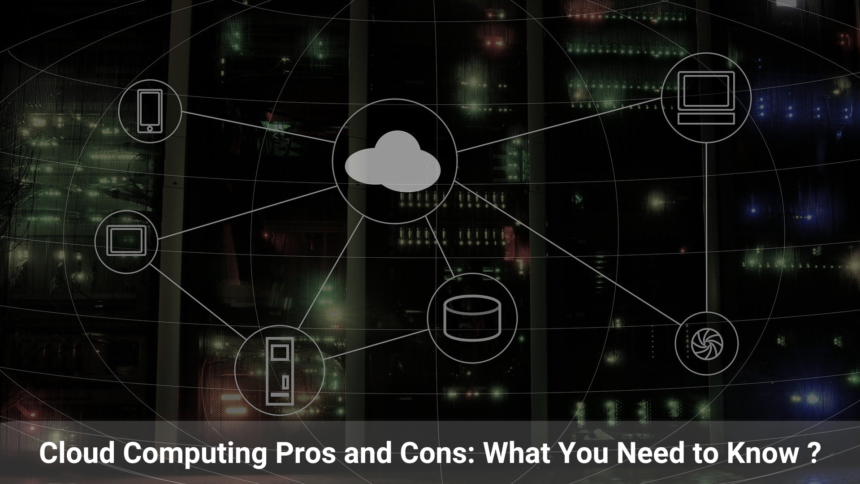Cloud Computing Pros and Cons
Cloud computing has come a long way since its early days and is now a crucial part of how businesses operate. It’s transformed the tech world by letting companies access computing resources and store data over the internet, without needing to invest in and maintain physical hardware. This shift has paved the way for more innovative and efficient business practices. Today, cloud computing supports a wide range of applications and services, driving digital transformation and reshaping traditional business models.
What does Cloud Computing means? A Brief Overview
At its core, cloud computing means delivering computing services—like servers, storage, databases, networking, software, and analytics—over the internet. Instead of relying on extensive on-premises hardware, businesses can access and manage these resources as needed from almost anywhere. This model offers incredible flexibility, allowing organizations to scale their IT resources up or down based on demand and only pay for what they use. By using cloud services, companies can streamline their operations, cut costs, and adapt more quickly to changes in the market.
Evolution of Cloud Computing: From Then to Now
Cloud computing’s evolution began with basic virtual machines and storage solutions, moving away from traditional hardware-based IT setups. In the early 2000s, the launch of public cloud services marked a new era of accessibility and cost-effectiveness. Over the past decade, the field has become much more advanced, with the introduction of hybrid and multi-cloud environments, serverless computing, and more sophisticated service models. Today, cloud computing is at the cutting edge of digital innovation, supporting complex applications and driving technological progress across various industries.
The State of Cloud Computing in 2024
As of 2024, cloud computing is a fundamental part of digital strategies, characterized by its dynamic and interconnected nature. The integration of advanced technologies like artificial intelligence and machine learning has significantly boosted cloud services, allowing organizations to gain deeper insights and drive innovation. There’s also a strong focus on sustainability, with green cloud initiatives aimed at reducing the environmental impact of data centers and promoting eco-friendly practices. With more businesses adopting multi-cloud strategies, the cloud landscape is evolving to offer even greater flexibility and resilience.
Key Trends Shaping Cloud Computing This Year
In 2024, several key trends are influencing the cloud computing landscape. Edge computing, which involves processing data closer to where it’s generated, is becoming popular to cut down on latency and improve performance. Artificial intelligence and machine learning are increasingly integrated into cloud services, enhancing automation and resource management. Additionally, there’s a growing emphasis on sustainability and green cloud initiatives, as organizations strive to reduce their carbon footprint and embrace environmentally responsible practices. These trends reflect the ongoing evolution of cloud computing and its role in advancing technology.

The advantage of Cloud Computing
Scalability: Adapting to Your Needs in Real-Time
One of the biggest advantages of cloud computing is its scalability. Businesses can quickly adjust their IT resources in response to changing demands, whether it’s a surge in traffic or seasonal fluctuations. This flexibility means companies only pay for what they use, avoiding the need for hefty upfront investments in hardware. Cloud computing’s on-demand scalability helps businesses adapt swiftly to market changes and operational needs, supporting growth and efficiency.
Cost Efficiency: Paying for What You Use
With cloud computing, businesses can avoid the hefty capital expenses of traditional IT setups. Instead of spending a lot on hardware and software, companies pay based on actual usage. This pay-as-you-go model not only cuts capital costs but also offers financial agility, helping organizations optimize their spending and allocate resources more effectively. By only paying for what they use, businesses can achieve better cost efficiency and align their IT investments with their needs.
Accessibility: Access from Anywhere, Anytime
Cloud computing changes the game in terms of accessibility. With just an internet connection, users can access applications, files, and data from almost anywhere in the world. This capability supports remote work, enhances collaboration, and enables global teams to work together seamlessly. By removing geographic barriers, cloud computing helps employees stay productive and connected no matter where they are, making flexible work arrangements more feasible.
Disaster Recovery: Ensuring Business Continuity
Cloud computing provides strong disaster recovery solutions, which are crucial for keeping businesses running smoothly. By storing data and applications across various locations, cloud services help organizations recover quickly from disruptions like natural disasters, cyberattacks, or hardware failures. This setup reduces downtime and protects important information, allowing businesses to get back to normal operations with minimal impact. Efficient disaster recovery is an essential part of a solid business continuity strategy.
Collaboration and Flexibility: Enhancing Team Productivity
Cloud computing boosts collaboration and flexibility, leading to improved team productivity. Cloud-based tools allow multiple users to work on shared documents and projects simultaneously, enhancing workflow efficiency and communication. Moreover, cloud computing supports flexible work arrangements, giving employees the tools and resources they need to collaborate effectively, regardless of their physical location.
Security Features: Built-In Protections and Compliance
Modern cloud providers offer a range of security features to protect data and ensure compliance with regulations. These include advanced measures like encryption, multi-factor authentication, and regular security audits. Cloud services also come with compliance certifications and frameworks aligned with industry standards, helping organizations meet legal and regulatory requirements. By utilizing these built-in protections, businesses can strengthen their security posture and reduce risks associated with data management.
Innovation and Integration: Leveraging the Latest Technologies
Cloud computing fuels innovation by offering access to the latest technologies and integration capabilities. Businesses can tap into artificial intelligence, machine learning, and big data analytics to drive growth and stay competitive. The cloud also makes it easier to integrate various applications and services, allowing organizations to build and deploy complex solutions quickly. Staying at the forefront of technological advancements helps companies harness the power of cloud computing to foster innovation and remain agile in a fast-paced digital world.

Drawbacks of Cloud Computing
Data Security Risks: Understanding the Vulnerabilities
Despite its many benefits, cloud computing comes with data security risks that need to be addressed. Centralizing data in the cloud can make it more vulnerable to breaches and unauthorized access. Cybercriminals may target cloud services to exploit weaknesses and compromise sensitive information. To combat these risks, organizations must implement strong security measures, such as encryption, access controls, and regular security assessments. A proactive approach to data security is essential for safeguarding valuable information in the cloud.
Compliance Challenges: Navigating Regulatory Requirements
Staying compliant with regulations can be a challenge in cloud computing. Organizations need to ensure their cloud providers meet relevant standards and maintain solid data protection practices. Regulations like GDPR, HIPAA, and CCPA impose strict rules on data handling, storage, and security. Navigating these compliance requirements requires a good understanding of regulatory obligations and a commitment to data privacy. Businesses should work closely with their cloud providers to ensure they meet all compliance needs.
Downtime and Reliability: Addressing Service Interruptions
Even with efforts to maintain high availability, cloud services can experience outages and interruptions. Downtime can affect business operations, leading to productivity losses and potential revenue drops. Organizations should assess their cloud provider’s reliability and uptime records, and have contingency plans in place for potential service disruptions. Implementing redundant systems and backup solutions can help reduce the impact of downtime and ensure business continuity.
Cost Management: Avoiding Unexpected Expenses
While cloud computing can save money, it can also lead to unexpected expenses if not managed properly. Overprovisioning, lack of optimization, and sudden spikes in usage can result in budget overruns. To avoid these surprises, businesses should closely monitor their cloud usage, use cost management tools, and optimize their resource allocation. Understanding pricing models and staying aware of potential cost drivers are key to maintaining financial control in the cloud.
Vendor Lock-In: The Risks of Over-Reliance on Providers
Vendor lock-in happens when organizations become too reliant on a specific cloud provider’s tools and services. This dependency can limit flexibility and make it harder to switch providers or integrate with different systems. To avoid the risks of vendor lock-in, businesses should consider multi-cloud strategies and choose providers that support interoperability and open standards. Keeping flexibility and not relying too much on a single vendor can help organizations adapt to changing technology landscapes.
Performance Issues: Handling Latency and Speed Concerns
Performance issues like latency and slow data access can impact user experience and operational efficiency. Latency, or delays in data transmission, can be particularly troublesome for applications that need real-time processing. To tackle these performance issues, organizations should evaluate their cloud provider’s performance metrics, optimize their configurations, and consider using content delivery networks (CDNs) to improve speed. Regular performance reviews and adjustments are crucial for maintaining optimal cloud performance.
Complexity in Management: Navigating Cloud Environments
Managing complex cloud environments can be tricky due to the variety of services and configurations involved. Organizations have to deal with different cloud components, like virtual machines, storage solutions, and network setups. Effective cloud management requires specialized knowledge, tools, and processes to ensure resources are allocated, secured, and optimized properly. Investing in cloud management solutions and training can help businesses handle these complexities and achieve operational efficiency.

Comparing Cloud Computing Models
Public vs. Private vs. Hybrid Cloud: What’s Best for You?
Choosing the right cloud model involves weighing the pros and cons of public, private, and hybrid clouds. Public clouds offer shared resources and cost savings, while private clouds provide dedicated infrastructure and more control. Hybrid clouds combine both approaches, allowing businesses to take advantage of the benefits of each based on their needs. Understanding the strengths and limitations of each model helps organizations make informed decisions and pick the best solution for their specific requirements.
Infrastructure as a Service (IaaS) vs. Platform as a Service (PaaS) vs. Software as a Service (SaaS)
Cloud computing comes in different flavors: Infrastructure as a Service (IaaS), Platform as a Service (PaaS), and Software as a Service (SaaS). IaaS gives you virtualized computing resources, so you can build and manage your own infrastructure. PaaS offers a platform for developing, testing, and deploying applications without dealing with the underlying infrastructure. SaaS provides software applications over the internet, removing the need for local installations. Knowing these models and their uses helps you choose the right solution for your needs.
Choosing the Right Cloud Model for Your Needs
Picking the right cloud model involves evaluating key factors like security, compliance, cost, and scalability. Organizations should align their cloud choice with their strategic goals and operational needs. A thorough assessment of current requirements and future growth prospects is essential for making the best decision. By carefully considering these factors, businesses can optimize their cloud investments and achieve their goals.
Cloud Migration Strategies
Planning Your Move to the Cloud: Key Considerations
Successful cloud migration requires detailed planning. Important factors include assessing your existing infrastructure, setting migration goals, and creating a comprehensive strategy. Evaluate your current IT environment, identify potential challenges, and develop a clear migration roadmap. Good planning ensures a smooth transition to the cloud and minimizes disruptions to your business operations.
Managing Data Migration: Ensuring a Smooth Transition
Data migration is about moving data from on-premises systems to the cloud. To ensure a smooth process, thoroughly test, validate data integrity, and address compatibility issues. Data migration tools and services can help minimize downtime and ensure accurate, secure data transfer. Proper management is crucial for maintaining business continuity and preventing data loss.
Best Practices for Cloud Adoption and Integration
Adopting cloud computing effectively involves conducting a needs assessment, choosing the right services, and implementing strong security measures. Set clear objectives for cloud adoption, evaluate potential providers, and develop strategies for integrating cloud services with your existing systems. Continuous monitoring and optimization are key to maximizing cloud benefits and ensuring efficient resource use.
The Future of Cloud Computing
The future of cloud computing is being shaped by new technologies like edge computing, quantum computing, and server less architectures. These innovations promise to boost cloud capabilities, offering better performance, scalability, and flexibility. Edge computing processes data closer to its source to reduce latency, while quantum computing could revolutionize data processing with unprecedented power. Staying updated on these technologies helps organizations prepare for future advancements.
Predicted Trends and Innovations for the Coming Years
Looking ahead, trends include greater integration of artificial intelligence and machine learning into cloud services, improvements in cloud security, and a stronger focus on sustainability. As cloud computing continues to evolve, businesses will benefit from innovations that enhance efficiency, security, and eco-friendliness. Staying informed about these trends helps companies leverage new technologies for growth and stay competitive in the digital age.
For more details visit our Computer section.









